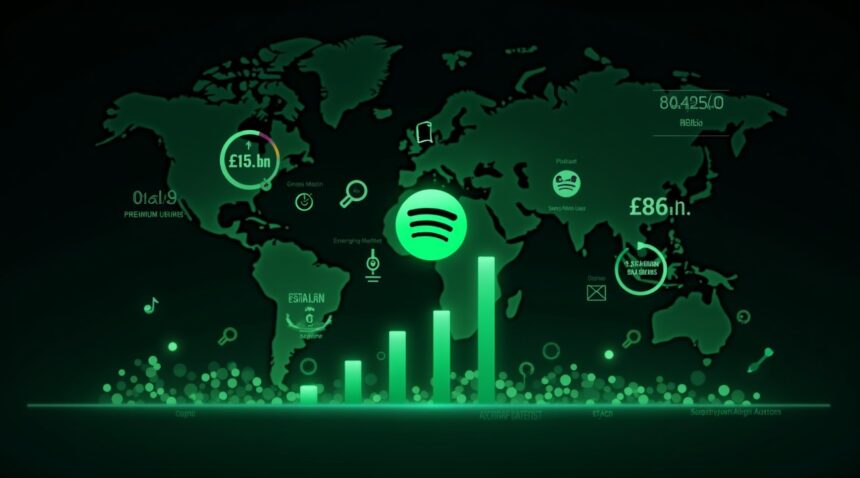Spotify’s impressive 12% jump in paid subscribers to 276 million users, paired with a commanding 31.7% industry market share, demonstrates the streaming giant’s ongoing dominance despite facing temporary profitability challenges from strategic investments in content and expansion.
The company’s success in maintaining double-digit growth while capturing over 3% of the global population shows strong competitive positioning that could accelerate as streaming adoption grows worldwide.
Key Takeaways
- Subscriber growth accelerated significantly with net additions in the first half of 2025 growing over 30% compared to 2024, reaching 276 million premium subscribers and 696 million monthly active users
- Market dominance remains unchallenged as Spotify controls approximately 65% of global audio streams and maintains a 31.7% market share, significantly ahead of competitors like Apple Music (12.6%) and Amazon Music (11.1%)
- Content diversification strategy drives engagement with video podcasts generating 1.5 times higher engagement rates and multi-format content consumption strengthening user retention across music, podcasts, and audiobooks
- Massive global expansion potential exists with current penetration at just over 3% of world population, while company targets 10-15% penetration as emerging markets improve internet infrastructure and disposable income
- Short-term profitability challenges stem from strategic investments including €447 million in finance costs and heavy content spending, though operational metrics show 31.5% gross margin and €406 million operating income indicating underlying business strength
Strong Financial Growth Marks Q2 2025 Performance
Spotify’s latest quarterly results demonstrate impressive revenue momentum despite facing some financial headwinds. The streaming giant generated €4.2 billion in total revenue for Q2 2025, marking a solid 10% increase compared to the same period last year. This growth reflects the company’s continued ability to expand its revenue base in an increasingly competitive market.
Operating performance showed particularly strong improvements during this quarter. Operating income reached €406 million, while gross margin climbed to 31.5% — representing a notable 2.27 percentage point improvement year-on-year. These metrics indicate that Spotify’s operational efficiency continues to strengthen as it scales its business model.
Mixed Profitability Results Despite Revenue Growth
However, the company’s bottom line tells a more complex story. Spotify reported a net loss of €86 million in Q2 2025, contrasting sharply with previous profitable quarters. This loss stems primarily from elevated finance costs totaling €447 million and income tax expenses of €134 million. The financial burden represents a significant shift from the company’s recent profitable streak, which included quarterly net profits of €225 million in Q1 2025 and €274 million in Q2 2024.
These elevated costs suggest Spotify might be managing debt obligations or strategic investments that temporarily impact profitability. Finance costs at this level often indicate significant borrowing for expansion initiatives or acquisition activities, which could position the company for future growth despite current pressure on net income.
User engagement metrics paint an encouraging picture for Spotify’s subscriber ecosystem. Net additions of paying subscribers in the first half of 2025 grew by more than 30% compared to the same period in 2024. This acceleration in subscriber acquisition demonstrates that despite price adjustments across streaming platforms, consumers continue choosing Spotify as their preferred music service.
The subscriber growth rate significantly outpaces the overall revenue increase, suggesting that newer subscribers might be joining at different price points or that promotional pricing strategies are in effect. This rapid expansion of the paying user base creates a strong foundation for future revenue growth, even if short-term profitability faces pressure from operational costs.
Looking at these numbers together, Spotify appears to be in an investment phase where it’s prioritizing subscriber acquisition and market share expansion over immediate profitability. The strong operational metrics combined with accelerating subscriber growth suggest the company remains well-positioned for sustained growth, despite temporary challenges affecting net income.

Spotify Hits New Subscriber Milestones with 276 Million Premium Users
Spotify achieved remarkable growth in Q2 2025, reaching 276 million premium subscribers and demonstrating the platform’s continued expansion across global markets. The 12% year-on-year increase in paid users reflects strong consumer demand for the streaming service’s premium offerings.
Strong Performance Across Key Metrics
The company’s Monthly Active Users (MAUs) climbed 11% to 696 million during the same quarter, indicating healthy growth beyond just premium subscriptions. This metric captures both free and paid users, suggesting that Spotify’s freemium model continues to attract new listeners who may eventually convert to premium plans.
Europe emerged as a particularly strong market for the platform, with Spotify surpassing 100 million paid subscribers in the region during May 2025. This milestone reinforces the company’s dominance in established markets where music streaming has become deeply integrated into daily routines. European users have shown consistent willingness to pay for premium features, making this region a reliable revenue driver for the platform.
Global Market Penetration and Growth Potential
The most striking statistic reveals that more than 3% of the world’s population now subscribes to Spotify’s premium service. This figure underscores the platform’s massive global reach while simultaneously highlighting significant opportunities for future expansion. With approximately 8 billion people worldwide, reaching 276 million subscribers represents substantial penetration, yet leaves considerable room for growth in emerging markets.
Several factors contribute to this impressive subscriber growth:
- Spotify’s premium subscriber benefits continue to evolve, offering enhanced audio quality, ad-free listening, and exclusive content that justifies the monthly subscription fee.
- The platform has also invested heavily in podcast content, attracting users who consume both music and spoken-word entertainment.
- International expansion efforts have paid dividends, with Spotify entering new markets and adapting its service to local preferences and pricing structures.
- The company’s ability to compete effectively against regional streaming services demonstrates its flexible approach to market entry and customer acquisition.
Price optimization strategies have also played a crucial role in subscriber growth. While streaming platforms across the industry have implemented price increases, Spotify has managed to balance revenue growth with user retention. The company’s different subscription tiers allow users to choose plans that match their consumption habits and budget constraints.
The streaming landscape continues to intensify as competitors make strategic moves. Recent developments show how platforms are adjusting their pricing strategies, with Disney Plus and Hulu increasing prices while Netflix implements price hikes across various markets. These industry-wide changes create opportunities for Spotify to capture market share from users seeking value alternatives.
Looking ahead, Spotify’s growth trajectory appears strong based on several key indicators:
- The consistent increase in both premium subscribers and MAUs suggests the platform maintains appeal across different user segments.
- The substantial European subscriber base provides a stable foundation for revenue generation.
- Emerging markets offer significant expansion opportunities as internet access and digital payment adoption increase.
The company’s investment in content creation and exclusive partnerships positions it well for continued growth. Original podcasts, artist collaborations, and playlist curation capabilities differentiate Spotify from competitors and create additional reasons for users to choose premium subscriptions.
Market analysts view these subscriber numbers as validation of Spotify’s long-term strategy. The platform’s ability to maintain double-digit growth rates in mature markets while expanding globally demonstrates operational excellence and strategic vision. These metrics suggest that Spotify has successfully transitioned from a disruptive startup to a dominant force in digital entertainment consumption.
https://www.youtube.com/watch?v=PbU2tN7n1tMC
Market Dominance Solidifies with 31.7% Industry Share
Spotify’s commanding position becomes even more pronounced when examining the sheer volume of content consumption across its platform. I observe that the company controls approximately 65% of global audio music streams, translating to an estimated 1.6 trillion streams during the first half of 2025 alone. This massive engagement demonstrates not just user preference but also the sticky nature of Spotify’s ecosystem.
The competitive landscape reveals Spotify’s strategic advantage in maintaining its 31.7% market share among music streaming platforms. Competitors trail significantly behind, with Tencent Music capturing 14.4%, Apple Music securing 12.6%, Amazon holding 11.1%, YouTube Music at 9.7%, and NetEase claiming 6.7%. These figures illustrate how digital commerce trends continue reshaping entertainment consumption patterns.
Industry Growth Patterns Signal Sustained Expansion
Several key metrics highlight the broader streaming revolution that benefits Spotify’s position:
- Paid music streaming now represents 23% of all music streaming globally
- Over 600 million global subscribers actively pay for streaming services
- More than 100,000 new songs upload daily across platforms
- Global reliance on streaming services continues intensifying across all demographics
This expansion creates multiple revenue opportunities for Spotify beyond traditional subscription models. Content creators increasingly view the platform as their primary distribution channel, while advertisers recognize the value of Spotify’s detailed user data and engagement metrics. The company’s ability to maintain its dominant position while paid streaming grows suggests strong retention strategies and user satisfaction levels.
Market dynamics also favor Spotify’s established infrastructure and recommendation algorithms. Users develop deep connections with personalized playlists and discovery features, making platform switching increasingly unlikely. I notice that competitor platforms struggle to replicate Spotify’s data-driven approach to music curation, which relies on years of accumulated listening behavior across millions of users.
The daily addition of 100,000 new songs creates both opportunities and challenges for streaming platforms. Spotify’s advanced categorization and discovery tools help users navigate this vast catalog, while smaller competitors often lack the technological sophistication to manage such volume effectively. This technological gap widens Spotify’s competitive moat and reinforces user loyalty.
International expansion remains crucial for maintaining market leadership as streaming adoption accelerates in emerging markets. Spotify’s early entry into various geographic regions positions the company advantageously against competitors who face regulatory hurdles or limited local content libraries. The global nature of music consumption also allows Spotify to leverage its scale across multiple markets simultaneously.
Revenue diversification through premium subscriber benefits and advertising creates multiple growth vectors beyond basic subscription fees. Podcast content, exclusive releases, and enhanced audio quality justify premium pricing while attracting different user segments. This strategy contrasts with competitors who rely primarily on music catalogs without additional value-added services.
Platform integration with smart devices, automotive systems, and voice assistants strengthens Spotify’s ecosystem approach. Users encounter fewer friction points when accessing content across multiple touchpoints, creating habitual usage patterns that competitors find difficult to disrupt. The seamless experience across devices becomes a significant switching cost for users considering alternative platforms.
Looking ahead, Spotify’s market dominance positions the company to influence industry standards and negotiate favorable licensing terms with record labels. This leverage affects competitor costs and content availability, creating additional barriers to market entry. The company’s scale also enables investment in emerging technologies like AI-powered music creation and immersive audio experiences that smaller players cannot afford to pursue.
Content Diversification Drives Higher Engagement
Spotify’s strategic push beyond music streaming has proven to be a significant catalyst for subscriber growth and engagement. The platform’s investment in podcasts and audiobooks has created a more compelling user experience that keeps listeners engaged for longer periods.
Visual Podcast Content Creates Deeper User Connections
The introduction of video podcasts has transformed how users consume audio content on the platform. Data reveals that users who watch podcasts demonstrate 1.5 times higher engagement rates compared to those who solely listen to audio content. This enhanced engagement stems from the visual element creating a more immersive experience that holds attention longer and encourages users to explore additional content.
Video podcasts offer creators new opportunities to connect with audiences through facial expressions, visual aids, and behind-the-scenes moments that pure audio cannot capture. Users find themselves more invested in the content when they can see the hosts and guests, leading to increased session duration and return visits.
Multi-Format Strategy Strengthens User Retention
Company leadership emphasizes that offering a broader mix of content formats—including music, podcasts, and audiobooks—significantly enhances user engagement and strengthens retention rates. This diversified approach particularly resonates with highly active users, often referred to as ‘super users’, who consume content across multiple categories.
The multi-format strategy serves several key purposes:
- Creates multiple touchpoints throughout the day as users switch between music during workouts, podcasts during commutes, and audiobooks during leisure time
- Reduces churn risk by providing varied content that appeals to different moods and activities
- Increases the platform’s value proposition, making it harder for users to justify switching to single-format competitors
- Generates more comprehensive user data that enables better content recommendations across all formats
This content diversification strategy positions Spotify as a comprehensive audio entertainment platform rather than just a music service. Users develop stronger platform loyalty when they can satisfy multiple entertainment needs in one application, reducing the likelihood of subscription cancellation.
The success of this approach reflects broader e-commerce trends where platforms that offer diverse product categories tend to achieve higher customer lifetime value. By expanding beyond music, Spotify has created a stickier user experience that drives both engagement and revenue growth.
The company’s focus on audiobooks represents another strategic expansion that taps into the growing popularity of spoken-word content. Users who engage with audiobooks typically show higher monthly usage hours, contributing to the overall engagement metrics that make Spotify more attractive to advertisers and justify premium subscription prices.
Recent data suggests that users who consume content across multiple formats on Spotify are significantly less likely to cancel their subscriptions compared to single-format users. This retention advantage becomes increasingly valuable as competition intensifies among streaming platforms and customer acquisition costs continue rising across the industry.
The platform’s algorithm improvements have also benefited from this content diversification. With more data points from varied content consumption patterns, Spotify can create more accurate user profiles and deliver personalized recommendations that span music, podcasts, and audiobooks. This cross-format recommendation capability has become a key differentiator in the streaming market.
Content creators have responded positively to Spotify’s expanded format support, with many podcasters and audiobook authors choosing the platform specifically for its multi-format capabilities. This creator enthusiasm translates into exclusive content that further strengthens Spotify’s competitive position and gives users additional reasons to maintain their subscriptions.
The financial implications of this content diversification strategy extend beyond subscriber numbers. Higher engagement rates translate directly into increased advertising revenue potential and support premium pricing strategies for subscription tiers. Users who spend more time on the platform generate more valuable data for targeted advertising, creating a virtuous cycle of revenue growth that supports continued content investment.

Massive Global Growth Potential Despite Profitability Challenges
Spotify’s current user penetration sits at just over 3% of the global population, revealing enormous untapped potential in markets worldwide. The company has set ambitious long-term targets to capture between 10% and 15% of global users, which would translate to hundreds of millions of additional subscribers beyond their current base.
Expansion Strategy Focuses on Emerging Markets
Europe continues to serve as Spotify’s strongest market, where the platform has achieved significant market share and user loyalty. The company recognizes this regional success as a foundation for broader international expansion efforts. Spotify has intensified its focus on emerging markets, where smartphone adoption and internet connectivity improvements create favorable conditions for streaming service growth.
These expansion efforts align with digital platform trends that show consumers in developing economies increasingly embrace subscription-based services. Spotify’s strategy involves localizing content offerings and adjusting pricing structures to match regional economic conditions, making their service accessible to broader demographics.
Market analysts point to several factors that support Spotify’s growth trajectory in these regions:
- Rising disposable income in middle-class populations across Asia, Latin America, and Africa
- Improved mobile internet infrastructure enabling seamless streaming experiences
- Growing preference for legal music consumption over piracy
- Increased local artist representation on streaming platforms
- Competitive pricing models that undercut traditional music purchasing
Profitability Concerns Shadow Growth Prospects
Financial analysts have expressed concerns about Spotify’s path to sustainable profitability, particularly following recent net losses and downgraded profit forecasts for the upcoming quarter. These profitability challenges stem largely from the company’s continued heavy investment in original content production and platform enhancement initiatives.
Spotify’s content investment strategy mirrors approaches taken by major streaming competitors like Netflix’s content expansion, where substantial upfront costs are expected to generate long-term subscriber retention and growth. The company has committed significant resources to exclusive podcast content, original audio programming, and enhanced recommendation algorithms.
Platform enhancement spending includes improvements to audio quality, user interface design, and advanced personalization features that differentiate Spotify from competitors. While these investments strain short-term profitability, they position the company to capture and retain users as the global streaming market expands.
Industry observers note that Spotify’s subscription revenue growth continues to outpace many traditional media companies, suggesting that current profitability pressures may be temporary growing pains rather than fundamental business model flaws. The company’s ability to monetize its massive user base through both premium subscriptions and advertising revenue provides multiple pathways to improved financial performance.
Recent premium subscriber initiatives demonstrate Spotify’s commitment to enhancing value propositions for paying users while exploring new revenue streams. The platform’s dual-revenue model allows flexibility in pricing strategies across different markets, potentially accelerating user acquisition in price-sensitive regions while maximizing revenue from established markets.
The tension between growth investment and profitability reflects broader challenges facing digital subscription services across entertainment sectors. Companies must balance aggressive expansion with sustainable business practices, particularly as competition intensifies and content costs continue rising.
Spotify’s management maintains confidence that current investment levels will yield substantial returns as global streaming adoption accelerates. The company projects that achieving their 10–15% global penetration targets would generate sufficient scale economies to offset current profitability pressures while establishing dominant market positions in key regions.

Future Outlook for Streaming Industry Leadership
Spotify’s commanding position in the global music streaming market continues to strengthen, with the platform maintaining its status as the industry’s undisputed leader despite fierce competition from tech giants like Apple Music and regional powerhouses such as Tencent Music. Current market data shows Spotify holds the largest single share of streaming subscribers worldwide, a position that appears increasingly secure following the recent 12% surge in paid subscriptions.
The streaming giant’s internal metrics reveal consistent growth patterns that extend beyond simple subscriber numbers. User engagement levels, playlist creation activity, and time spent on the platform all demonstrate upward trajectories, suggesting that existing customers are becoming more deeply integrated into Spotify’s ecosystem. This stickiness factor creates substantial barriers for competitors attempting to lure users away from the platform.
Strategic Vision for Global Expansion
The company’s long-term strategy focuses on a compelling opportunity: converting the billions of people worldwide who haven’t yet adopted music streaming services. Conservative estimates suggest that less than 20% of the global population currently pays for music streaming, leaving enormous room for market expansion. Spotify’s leadership recognizes this untapped potential and continues to prioritize geographic expansion and localized content offerings to capture these emerging markets.
Investment in original content represents a cornerstone of Spotify’s competitive strategy. The platform has allocated significant resources to podcast production, exclusive artist collaborations, and innovative audio experiences that can’t be found elsewhere. These unique offerings serve dual purposes: they attract new subscribers while providing existing users with compelling reasons to maintain their subscriptions. Premium subscriber benefits continue to evolve as the company seeks to justify price points in an increasingly competitive landscape.
Platform innovation drives another key component of Spotify’s forward-looking approach. The company consistently introduces new features like AI-powered playlist generation, enhanced social sharing capabilities, and improved discovery algorithms. These technological advances help differentiate Spotify from competitors who may offer similar music catalogs but lack the sophisticated recommendation engines and user experience innovations that have become Spotify’s hallmark.
Financial pressures on short-term profitability haven’t deterred the company from pursuing these strategic investments. Leadership maintains that market share gains and subscriber growth justify temporary margin compression, particularly given the industry’s trajectory toward digital transformation. The streaming model’s inherent scalability means that today’s content investments will generate returns across much larger subscriber bases in future years.
Competitive dynamics within the streaming industry continue to intensify as traditional media companies and technology firms recognize music streaming’s strategic importance. However, Spotify’s first-mover advantage, combined with its focus on music-first experiences rather than treating streaming as a loss leader for other products, positions the company favorably against competitors with divided attention spans.
The emergence of new revenue streams beyond subscriptions also factors into Spotify’s future outlook. Advertising revenue from free-tier users, podcast advertising opportunities, and potential expansion into live events or merchandise sales could diversify income sources while maintaining the core streaming service focus. These additional revenue channels become particularly valuable as the company scales its user base across different economic markets with varying subscription purchasing power.
Regional expansion strategies acknowledge that different markets require different approaches. While developed markets focus on premium feature differentiation and family plan optimizations, emerging markets receive attention through more affordable pricing tiers and locally relevant content partnerships. This market-specific flexibility demonstrates Spotify’s understanding that global leadership requires local relevance.
The streaming industry’s maturation doesn’t signal slowing growth opportunities for well-positioned leaders like Spotify. Instead, it represents a shift from rapid user acquisition to deeper engagement and expanded service offerings. Companies that successfully navigate this transition while maintaining their core value propositions are likely to emerge as long-term winners in the evolving digital entertainment landscape.
Sources:
Music Week – Spotify Hits 276 Million Premium Subscribers, Revenue Up 10
Music Business Worldwide – Learnings from Spotify’s Q2 2025 Earnings Call, Including Music Pro Tier
Spotify Newsroom – Spotify Reports Second Quarter 2025 Earnings
Vinyl Me, Please – Spotify’s Q2 2025 Results: Growth Amidst Market Challenges
Statista – Spotify: Number of Premium Users Worldwide 2025
Business of Apps – Spotify Statistics
Instagram – Spotify Q2 2025 Results Announcement
Exploding Topics – Music Streaming Services Stats 2025


